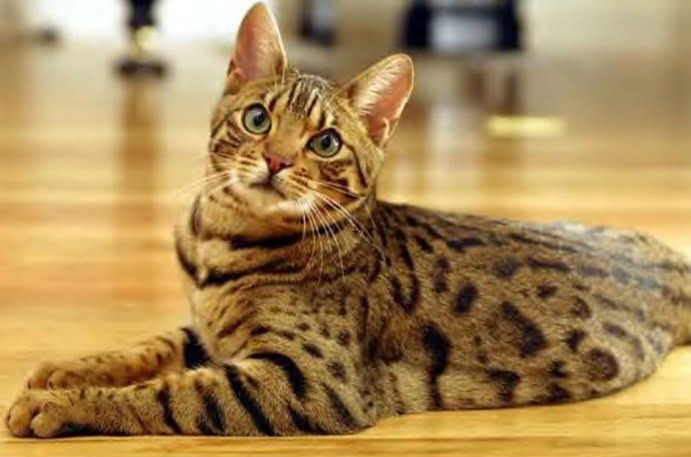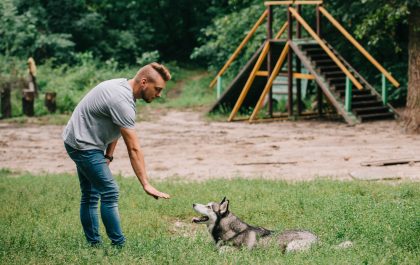Size: Medium-sized cat, weighing between 4-7kg
Coat: Short, soft, and dense fur with distinctive markings
Temperament: Active, intelligent, and curious
Lifespan: Average lifespan of 12-16 years
Health Issues: Prone to certain genetic conditions such as Hypertrophic Cardiomyopathy and Progressive Retinal Atrophy
Grooming: Low maintenance grooming, brushing once a week is sufficient
Activity Level: High energy and require regular exercise and play time
Training: Highly trainable and can learn tricks and commands
Social Needs: Affectionate and social cats that thrive on attention and interaction
Feeding: Require a balanced diet of high-quality protein and appropriate portion control to maintain a healthy weight
Are you interested in learning more about the Bengal Cat? This article will provide you with a comprehensive overview of this unique breed of cat. From their physical traits to their personality and temperament, this article will give you a better understanding of the Bengal Cat. We will also discuss their history, care requirements, and health issues. So if you are considering adding a Bengal Cat to your family, you can expect to gain a lot of information from this article.
History and Origin of the Bengal Cat
The Bengal Cat is a breed of domestic cat that originated in the United States in the 1980s. It is the result of crossing a domestic cat with an Asian Leopard Cat. The Bengal Cat is a medium-sized cat with a muscular, sleek body and a wild, exotic appearance. They have a spotted or marbled coat that can range from yellow to brown in colour. They are known for their intelligence, affectionate nature, and active personalities.
Bengals have been around since the early 1980s, when Jean Mill, a breeder in California, first crossed a domestic cat with an Asian Leopard Cat. Mill was fascinated by the wild cats of the world and wanted to create a domestic cat that had a wild appearance. She worked with the University of California, Davis to create the first Bengal Cat. The breed was officially recognized by The International Cat Association (TICA) in 1991. Bengals have since become popular in Australia, where they are seen as an exotic and unique pet. They are also known for their intelligence, affectionate nature, and active personalities.
Physical Characteristics and Appearance of Bengal Cats
Bengal cats are a unique breed of cats, known for their striking physical characteristics and appearance. They have a wild, leopard-like appearance, with a spotted or marbled coat and bright, vivid colours. Their large, round eyes are usually green or gold in colour, and their ears are wide and set high on their heads. Bengals also have a muscular body, with strong, powerful legs and a long, thick tail.
The Bengal’s coat is one of its most distinctive features. It is short and silky, with a unique pattern of spots or marbling. The colour of the coat can range from brown, black and silver to golden, orange and white. Bengal cats also have a unique pattern of stripes and spots on their legs and tail, which is known as the ‘glitter gene’. This gene is responsible for the sparkles that often appear on the coat of the Bengal cat.
Personality Traits and Temperament of Bengal Cats
Bengal cats are known for their unique personalities and temperaments. They are an active and intelligent breed that loves to explore and play. They are also very social and affectionate, making them a great choice for families.
Bengal cats are known to be quite vocal, so it is important to be prepared for the occasional meow or chirp. They are also quite active and need plenty of exercise and stimulation. They are also known to be quite independent and can be quite determined when it comes to getting what they want. They are also very curious and love to explore their environment. They are also quite intelligent and can be trained to do a variety of tricks. They are also very loyal and affectionate cats, making them a great companion for anyone looking for a loving pet.
Training and Exercise Needs of Bengal Cats
Bengal cats are a beautiful breed of cat that are known for their intelligence and active nature. As such, they have specific exercise and training needs that must be met in order to ensure they remain healthy and happy.
Exercise is essential for Bengal cats, and it is important to provide them with plenty of opportunities to run, jump, and play. This can be done in the home by creating an obstacle course or providing toys and scratching posts. Additionally, Bengal cats enjoy going outside, so it is important to ensure they are kept safe with a harness and leash. Taking them for regular walks is also beneficial, as it provides them with the opportunity to explore and interact with their environment.
Training is also important for Bengal cats, as it can help to keep them mentally stimulated and prevent behavioural problems from developing. Teaching them basic commands such as sit, stay, and come can help to establish a strong bond between you and your cat. Additionally, providing them with enrichment activities such as puzzle toys can help to keep them engaged and reduce boredom. Finally, it is important to provide positive reinforcement when they do something correctly, as this will help them to associate the desired behaviour with rewards.
Feeding and Nutrition Requirements for Bengal Cats
Bengal cats are an exotic breed of cats that require special care when it comes to their feeding and nutrition requirements. These cats are particularly active and need a diet that will provide them with the energy they need to stay healthy and active.
When it comes to feeding your Bengal cat, it is important to provide a balanced diet that includes both wet and dry food. Wet food should be high in protein and should be fed twice a day. Dry food should also be high in protein and should be fed once a day. It is also important to provide your Bengal cat with plenty of fresh water throughout the day.
It is also important to provide your Bengal cat with a variety of treats and supplements. These should include vitamins and minerals, as well as fatty acids, which are essential for a healthy diet. It is also important to provide your Bengal cat with plenty of exercise to ensure they stay healthy and active. Regular visits to the vet are also important to ensure your Bengal cat is receiving the best nutrition possible.
Health Issues and Common Diseases in Bengal Cats
Bengal cats are a unique and beautiful breed of cats that are popular among pet owners due to their wild appearance and playful personalities. However, like all cats, Bengal cats are prone to certain health issues and common diseases that pet owners should be aware of.
One of the most common health issues in Bengal cats is polycystic kidney disease (PKD). This is a genetic disorder that can cause the kidneys to become enlarged and can lead to kidney failure. Other health issues that Bengal cats may experience include heart defects, respiratory problems, and eye problems such as conjunctivitis. It is important for pet owners to be aware of these potential health issues and to take their Bengal cat for regular check-ups and vet visits.
In addition to the health issues mentioned above, Bengal cats are also susceptible to certain common diseases. These include feline leukemia, feline immunodeficiency virus, and feline infectious peritonitis. It is important for pet owners to vaccinate their cats against these diseases and to keep them up to date with their vaccinations. Furthermore, pet owners should also practice good hygiene and regularly clean their cat’s litter box to reduce the risk of disease.
Grooming and Care for Bengal Cats
Bengal cats are known for their luxurious fur and striking markings. To ensure that your Bengal cat looks and feels its best, it is important to groom them regularly. Grooming is an important part of maintaining your Bengal cat’s health and wellbeing.
Bengal cats have a short, fine coat that should be brushed at least once a week. This will help to prevent tangles and mats, as well as remove any dirt and debris that may have become trapped in the fur. It is also important to keep their nails trimmed to prevent them from becoming overgrown and uncomfortable. You should also check their ears for any signs of infection, as well as inspect their eyes for any signs of discharge or irritation. Regularly bathing your Bengal cat is not necessary but can be beneficial to help keep their coat clean and free of any dirt or debris.
In addition to grooming, it is important to provide your Bengal cat with a balanced and nutritious diet. This will help to ensure that they are getting all the essential nutrients they need to stay healthy. It is also important to provide plenty of fresh water and to keep their litter box clean and free of any waste. Lastly, it is important to provide your Bengal cat with plenty of love and attention. This will help to ensure that they stay happy and content.
Final Thoughts
the Bengal Cat is an exotic and unique breed of cat that is known for its wild appearance and active personality. They have a unique coat and pattern of stripes and spots, as well as large, round eyes and wide, set ears. They are an intelligent and affectionate breed that loves to explore and play. They also have specific exercise and training needs, as well as feeding and nutrition requirements. Finally, it is important to be aware of the potential health issues and common diseases that Bengal cats may experience. With the right care and attention, a Bengal cat can make a wonderful and loyal companion for any family.
Bengal Cat FAQs
Yes, Bengal cats make great pets. They are loyal, friendly, and enjoy human interaction. However, they require a lot of attention and exercise to keep them happy and healthy.
Bengal cats are generally good with children, as they enjoy playing and being active. However, as with any pet, it is important to supervise interactions between children and cats to ensure both are safe and happy.
No, Bengal cats are not hypoallergenic. They produce the same allergens as other cats, but some people may be less sensitive to them.
Bengal cats can be prone to certain health issues such as hypertrophic cardiomyopathy and progressive retinal atrophy. It is important to have regular check-ups with a veterinarian.
You can adopt a Bengal cat from a reputable breeder or rescue organization. Before adopting, make sure you research the breed and choose a cat that fits your lifestyle and personality.
Bengal cats are active and energetic. They love to play and explore their surroundings. They are also social and enjoy the company of their owners.
Bengal cats require regular grooming, a balanced diet, and plenty of exercise and playtime. They also need a stimulating environment with toys and scratching posts.
Bengal cats are a relatively expensive breed, with prices ranging from $1,000 to $5,000 or more depending on the cat’s pedigree and quality. It is important to purchase from a reputable breeder and avoid buying from pet stores or online marketplaces.
Bengal cats have a distinctive coat that is covered in spots, with a wild-looking appearance that is often described as “ferocious”. They are known for their playful and curious nature, as well as their intelligence and ability to learn tricks.
Bengal cats are known for their distinctive coat markings, which resemble those of a wild leopard or jaguar. They are also highly energetic, intelligent, and vocal, and have a muscular, athletic build.
A Bengal cat is a breed of domestic cat that originates from the crossing of an Asian leopard cat and a domestic cat.
The average lifespan of a Bengal cat is 12 to 16 years. With proper care, they can live even longer.
Bengal cats can live between 12 and 16 years, depending on their overall health and wellbeing.
Bengal cats have a short, dense coat that does not require a lot of grooming. However, they do shed regularly and may need to be brushed occasionally to remove loose hair.
Bengal cats were first created in the 1960s by breeding an Asian leopard cat with a domestic cat. The breed was recognized by the International Cat Association in 1983.
Bengal cats typically live for 12-16 years, which is slightly longer than the average lifespan of a domestic cat. However, like all cats, their lifespan can be affected by various factors such as genetics, diet, and lifestyle.
Bengal cats are highly active and playful, and love to climb, jump, and explore. They are also intelligent and curious, and enjoy interacting with their owners.
Bengal cats are medium to large in size, with males typically weighing between 4.5 and 6.8 kilograms and females weighing between 3.6 and 5.4 kilograms.
Bengal cats are known for being very active and playful, with a lot of energy and a strong hunting instinct. They are also highly intelligent and can be trained to do tricks or even walk on a leash. However, they can also be quite vocal and demanding, and may not be the best choice for a quiet household.
Bengal cats can be found from reputable breeders, animal shelters, or rescue organizations. It is important to do thorough research and ensure the breeder or organization is ethical and follows proper breeding practices.





